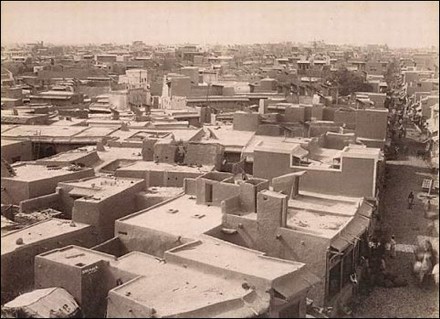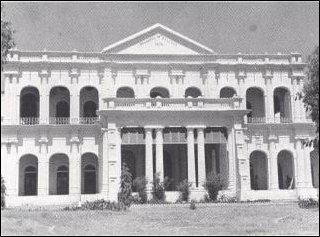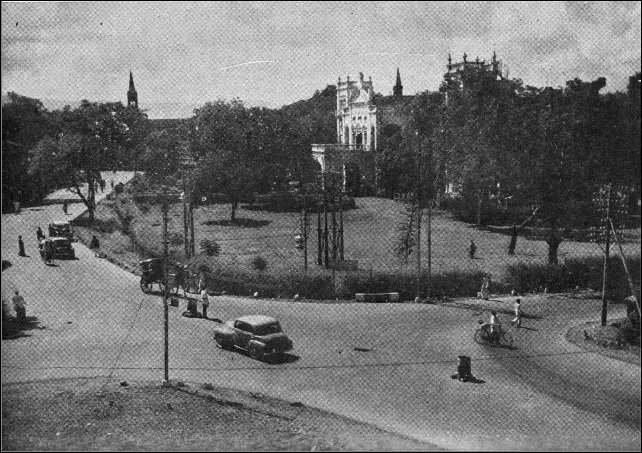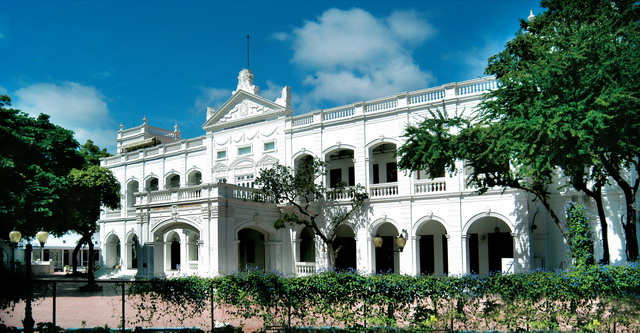 Home > The Mission | |
|
The Mission The Gurus Dada's Teachings Mission Activities Publications Worldwide Centers Picture Galleries Panama Center Center Activities Center Events Nuri Granth Anjali Sangraha Selected Lyrics  Selected Audio   Videos  |
The Sadhu Vaswani Mission What we know as the Sadhu Vaswani Mission today, was started by Sadhu T.L Vaswani in 1929, at Hyderabad (Sindh). Kumari Shanti Maghanmal was a devout disciple of Sadhu T.L Vaswani. At her behest, her father offered a hall where Sadhu Vaswani could hold his satsang (fellowship meetings). In those days it was known as the Sakhi Satsang. In the early days of the Sakhi Satsang, it was largely composed of women. For in an age when the woman's place was considered to be largely confined to the kitchen, Sadhu Vaswani was a visionary who believed that women had a great potential – a great shakti – which could be utilized for the betterment of the society and the nation. Sadhu Vaswani believed that service and sacrifice were the most vital aspects of the spiritual life. Under his guidance the satsang was a dynamic organization, rendering service to the community of Hyderabad – Sindh. A monthly magazine called Sant Mala published by the satsang carried beautiful articles by SadhuVaswani on the lives and teachings of Saints. The welfare department of Sakhi Satsang soon opened a shop called Sakhi Stores meant exclusively for women and managed by women too – a truly revolutionary idea for its times, and for the conservative society of Hyderabad-Sindh! The shop sold stationary, articles of daily use and swadeshi cloth, and was highly popular among the womenfolk. Wholesalers and distributors gave articles and textiles to the shop at cost price, for they knew that they were contributing to a worthy cause. All profits from Sakhi Stores were spent in the service of the poor and needy. Since the shop bore the stamp of the sacred name of Sadhu Vaswani, people accepted the novel idea whole-heartedly. Everyday between 5 and 6 p.m. Sadhu Vaswani took up “duty” at the store. His presence brought to mind the very image of Guru Nanak, and the rush during this hour was very heavy indeed. As he sold swadeshi cloth to women, he urged, “Chant Satnam when you wear this cloth.” Children came to the shop to buy paper, pencils, biscuits and sweets. They chanted satnam as they received those articles from Sadhu Vaswani. Parpati Malkani, one of the earliest devotees of the saint, kept the account scrupulously. Sadhu Vaswani himself looked into the accounts from time to time, and as he did so, he would tell his volunteers: “Honesty is its own reward.” The activities and departments of the Sakhi Satsang grew rapidly. More and more sisters came forward to offer their services in the noble cause undertaken by the association. These women gave of their time and effort freely, generously and in the true spirit of love and service advocated by their beloved Master. In so doing, they found a new meaning in their own lives, and began to know what fulfillment was like. On 4th June, 1933, The Mira School for girls was inaugurated in rented premises. The school was the cornerstone of the Mira Movement in Education. It was the vision of Sadhu Vaswani to create a school for girls, based on the ideals of new education. A number of men who were inspired by the master begged him to permit them to join his satsang. The Master graciously consented and the satsang and its activities were thrown open to all. Sakhi satsang now became the Brotherhood Association. Sadhu Vaswani's service programs in social, educational, cultural and humanitarian aspects greatly benefited the province of Sindh. His activities grew and flourished until Partition forced the Sindhis to leave their beloved motherland and migrate to India. The Pune EraAfter a brief sojourn in Bombay, on 13th Feb. 1949 Sadhu Vaswani came to live in Pune, the historical city of the Peshwas, which is also renowned as the cultural capital of Maharashtra. Fellowship meetings (satsangs) soon commenced at Panday Cottage, marking the historical commencement of the Pune Satsang which still attract thousands of Sadhu Vaswani's devotees from all over the world. Soon thereafter, the satsang had to be shifted to the bungalow of a devotee, Bhai Ramchand Daryanani, so that the ever- growing number of the faithful could be accommodated. At the Pimpri refugee camp on outskirts of Pune, many thousands of Sindhis who were forced to flee their homeland after partition were living in abject poverty. Sadhu Vaswani helped these displaced people as much as he could, and also urged his wealthy devotees to look after their brothers and sisters in distress. And so began the Welfare Department of the Pune Mission. On Guru Nanak's birthday, Sadhu Vaswani opened a grocery store, where the affluent purchased grains and other basic necessities and donated them to the poor and the needy. Fifty years on, the mission of help and healing still continues. Sadhu Vaswani's presence in Pune began to be felt very soon. At a crowded gathering in Gokhale Hall, he shared the dais with Maharishi Karve, who introduced him to the citizens of Pune as “The saint of Sindh.” He said that it was city's good fortune that a holy man of Sadhu Vaswani's caliber had come to live there. What Hyderabad had lost, Pune had gained! On January 26, 1950, a Charitable Dispensary was started. It was followed by a modest working centre for women, where needy sisters could earn their livelihood by sewing and tailoring. It was Sadhu Vaswani's wish that the Mira School for Girls should be re-opened in Pune. To begin with, St. Mira's school functioned out of temporary premises in the Secretariat Office in Pune! The Chief Minister of Bombay, Mr. B.G Khan, an admirer of Sadhu Vaswani and his work, gave permission for this. Around this time, Jeejeebhoy Castle, a beautiful heritage building located in the heart of Pune, not far from the station, fell vacant. By then, the Assembly Session was due to begin and the Secretariat had to be vacated. The Government of Bombay promptly requisitioned Jeejeebhoy Castle and handed it over to the Mira School. The rent was quite reasonable.  On the ground floor of the Building was a spacious hall, where the satsang began. In this hall was put up the beautiful portrait of St. Mira which Shri Gangaram had brought carefully, all the way from Hyderabad Sindh. In due course, this Hall came to be known as the Mira Hall.  Soon thereafter, Sadhu Vaswani left Panday Cottage and came to live in a small section of the Building. He took up his living quarters on the first floor, and began to live in the room which is still sacred to thousands of his devotees as the kutiya. However, he insisted that he would pay a monthly rent to the institution for his personal accomodation. This building became the headquarters of the Sadhu Vaswani Mission. It also became a place of pilgrimage for many aspiring souls who came from far and wide to have a glimpse of Dada, to visit the sacred samadhi of Sadhu Vaswani and to pray at the kutiya where he had spent the last days of his blessed life.  Renovation of the MissionIn the 1990s, restoration of the beautiful building became overdue. There was a need to ensure structural safety of the ancient building and also to expand the Mira Hall where thousands of devotees gathered for Satsang. The renovation work was scheduled to start on August 12, 1999. Volunteers helped in the task of shifting the relics of Sadhu Vaswani. The sacred kutiya was shifted to the ashram; Dada J PVaswani's personal collection of books was shifted out to be numbered and catalogued by the Librarian of St. Mira's College. The satsang hall was shifted to Naam Nagar – at the Runwal Regency Building just opposite the Mission. The devotees could just step across the road, to visit the sacred Samadhi as usual, before and after the satsang ! Four showrooms on the ground floor of Runwal Regency had been donated for the use of the Mission by Shri. Chandru Budhrani for the purpose of holding satsang and the other departments of the Mission. Dada himself moved out to a spacious Duplex Flat at Konark Estate – graciously offered for his stay during the entire period of the renovation by Mrs.Situ and Mr. Dharmu Chandiramani. Rennovation of the Dada Darshan, a heritage building, took over three years, at a total cost of approximately Rs.13 crore.  The brand new Morebai Naraindas hall was consecrated on the occasion of Dada's 84th birthday celebrations. The first satsang in the new hall was held on July 15th, 2002.
|